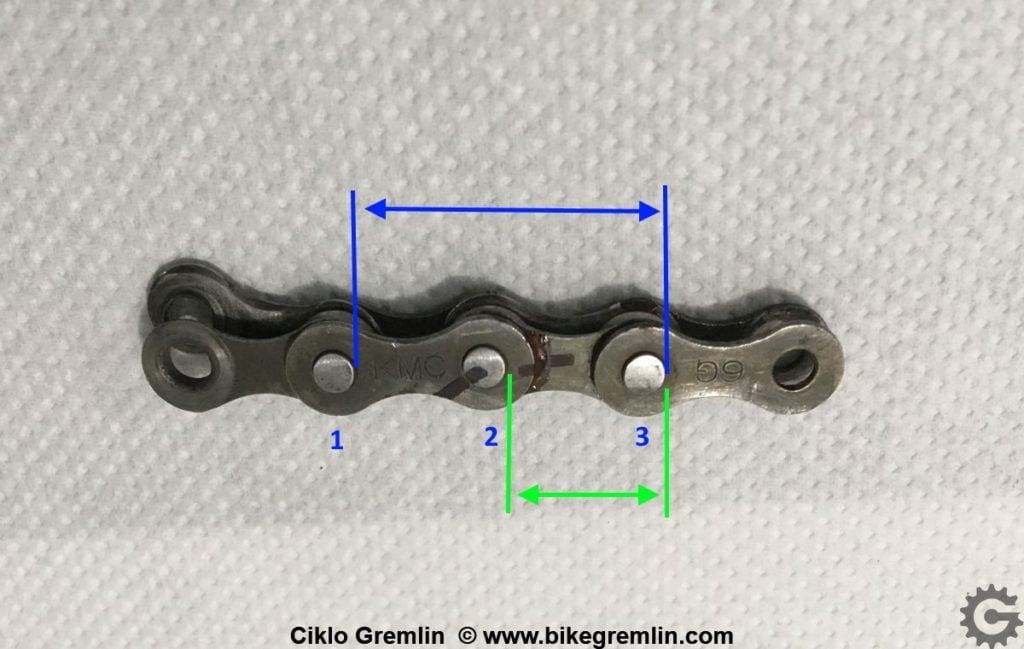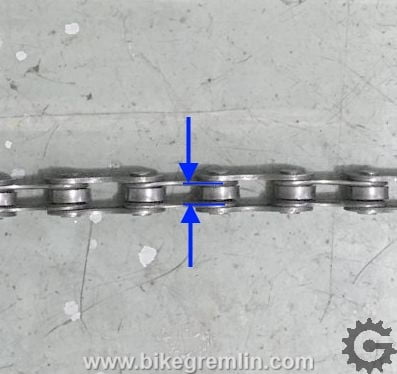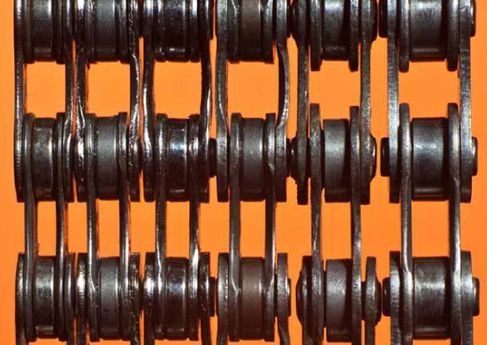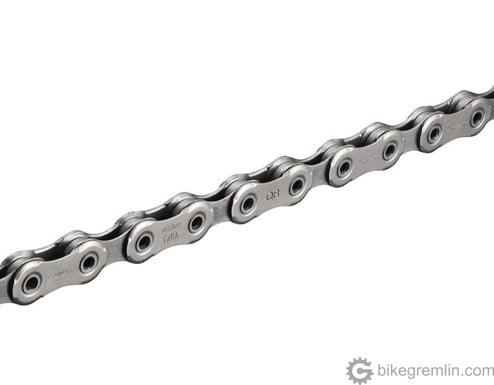This post will give an overview of bicycle driving chains standard dimensions. Each chain has three important dimensions: pitch, inner width and outer width.
If you have any questions (or additions and corrections), please use the BikeGremlin forum:
www.bikegremlin.net
Table Of Contents (T.O.C.):
- Bicycle driving chain pitch
- Chain inner width
- Chain outer width
3.1. Bicycle chain width standards table - Bicycle “chain construction and standards” video
TL/DR
If you read this, you will know:
- How long is a bicycle chain link (this is called “chain pitch“)?
- How do chain inner widths differ depending on the number of speeds (why do the high-speed narrow chains get stuck on single speed wide chainrings)?
- How do chain outer widths differ (why do low-speed wide chains get stuck between high-speed narrowly spaced cassette sprockets)?
I’ve also added a chain width table.
1. Bicycle driving chain pitch
Chain pitch is the distance at which the pins are placed. It is measured by measuring the distance between 3 links, then dividing it by two.

Picture 1
For detailed explanation of chain pitch, and why measuring three pins gives a more accurate result read the post Chain wear (“stretching”). For this post it suffices to say that bicycle chain pitch is exactly 1/2 inch (12.7 mm). This goes for all the bicycle chains, regardless of the speed number.
2. Chain inner width
Inner chain width is the spacing between a pair of inner plates. It is marked in the picture 2.

Picture 2
For inner chain width there are the following standard dimensions:
- Single speed chains have inner width of 1/8″ (3.175 mm).
- Multi speed chains, from 5 to 8 have inner width of 3/32″ (2.38 mm).
- Multi speed chains from 9 to 12 speeds have inner width of 11/128″ (2.18 mm).
- “Exotic” standard for freight bicycles is 5/32″ (4 mm).
3. Chain outer width
Chains for one and multiple speeds differ from each other by the outer width. The more “speeds” a chain is designed for, the thinner the outer plates and shorter the pins are (and they protrude less) – so the outer chain width is smaller (i.e. chain is narrower). Inner width of all the multi speed chains is almost the same – with only single speed chains having a significantly larger inner width.

Campagnolo 11 speed, SRAM 10 speed, Shimano 9 sp, SRAM 6/7/8 sp, old 5 speed, 1/8″ single speed chain
Picture 3
Note how rollers of all the multispeed chains are of almost the same width, only single speed chain being significantly wider on the inside.
Pitch is the same for all the chains – they are aligned by length.
As can be seen from the picture 3, the outer width differs mostly. This is important for bikes with multiple sprockets, so the chain doesn’t get stuck (too wide), or drop between the sprockets (too narrow – this latter case is practically never a problem in practice).
See this great post by “Graeme_FK” on the Cycle Chat forum for an in-detail explanation of the “fine print” in terms of Campagnolo vs Shimano vs SRAM vs 1x chain compatibility and size differences.
Help BikeGremlin
stay online & independent
This website is educational, free, objective, and not commercial
(sponsors don’t enjoy paying if you mention all the product downsides that you notice 🙂 ).
How much does a WordPress website cost?
If you find this site to be good and helpful,
and if $5 per month is what you can afford to set aside,
please consider supporting my work with a Patreon donation:
3.1. Bicycle chain width standards table
Table 1 gives an overview of chain outer dimensions, by number of speeds.
| Number of sprockets (speeds) a chain is designed for | Chain’s outer width in mm |
|---|---|
| All 6 speed | 7.8 |
| All 7 speed | 7.3 |
| All 8 speed | 7 ~ 7.3 * |
| All 9 speed | 6.5 – 6.7 |
| 10 speed old Campagnolo standard | 6.2 |
| All other 10 speed | 5.84 – 6.1 |
| All 11 speed | 5.46 – 5.74 ** |
| SRAM 12 speed MTB | 5.25 |
| Shimano 12 speed MTB | n/a |
| Campagnolo 12 speed | 5.15 |
| Campagnolo Ekar 1×13 speed | 4.9 |
| Rotor 1×13 | Uses SRAM 12-speed MTB chain standard |
** See the two comments by Klaus here (thanks for the valuable feedback),
until I double check and confirm.
4. Bicycle “chain construction and standards” video
My video explaining bicycle chain construction and dimension standards:
For an overview of which chains can be combined with which sprockets, read this post: Bicycle chains compatibility:

If you have any questions (or additions and corrections), please use the BikeGremlin forum:
www.bikegremlin.net
The existing comments posted under this article (questions and answers) have been moved to this BikeGremlin forum thread:
https://www.bikegremlin.net/threads/bicycle-drive-chain-standard-dimensions-article-comments.122/


I’m look in ng for a 2″ gear that will roll on a bike chain but only a 1/2″ slit X 1/16″ on the id instead of a circular hole.. can anyone help?
Hi, I heard that about 3 years ago SRAM increased the roller’s diameter of their 11 speed chain from 7.64mm to 7.7mm, and hence you cannot check the wear with a simple 2 point wear check tool, you need 3 point tool. Is this something you also noticed?
Hi Leon,
That’s a good question.
I don’t understand why manufacturers keep selling the inherently imprecise chain wear tool models. In a separate article, I’ve explained how to accurately check chain wear (and why the common 2-point checking tools are bad).
I either use the proper, Shimano’s chain checker, or a steel ruler. Common chain checkers are used just to let me know if I should double-check with a proper tool.
I’ve also made an experiment to see if roller wear affects chain engagement.
Relja
The other day I got a new M9100 12-speed Shimano chain and had to remove a few links. Much to my surprise and disappointment, my Park CT 4.3 doesn’t fit properly. It got the job done, but not in a great way. A bit of a kludge. I later found on the Park Tool site that the CT 4.3 is incompatible and has been discontinued. I guess with the various new chains on the market, the shapes have changed and by having a tool that cast in the shape of a symmetrical link, they’ve made the tool obsolete. I’m thinking of trying to modify my CT 4.3 to make it still useful. Have you ever compared the side profile of a 12 & 11 speed link and compared where they differ? Thanks
Hi Ric,
Here, I wrote about the Shimano XTR CN-M9100 chains.
So, it’s not about the “number of speeds” as the chain is designed to work with both 11 and 12-speed cassettes. The “catch” is most probably in the plate profile.
In the mean time, I bought Unior Master Chain Tool 1647/2BBI (link to my video presentation). However, I’m yet to test it with an M9100 chain, so can’t confirm if it works smoothly (but it does work with SRAM flat-top and Campagnolo chains at least). As those chains are very rare in my country, I may need to buy one just to test the tool (and send the info back to Unior 🙂 ).
Relja
Thanks very much. Im going to try to compare the plate profile and see if there’s anything I can do to file out mine